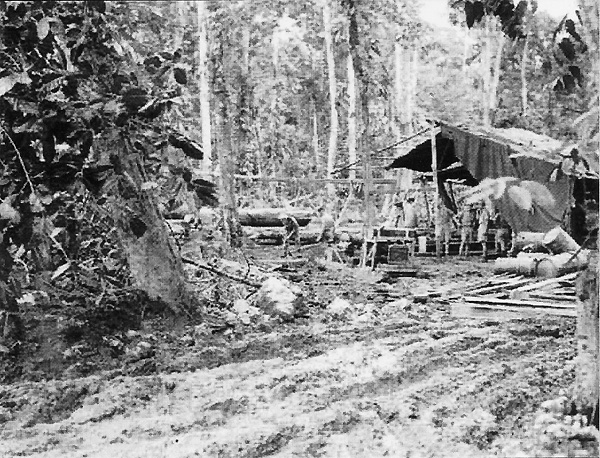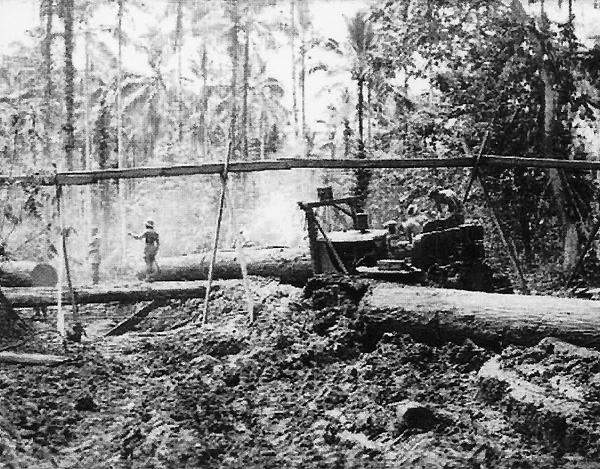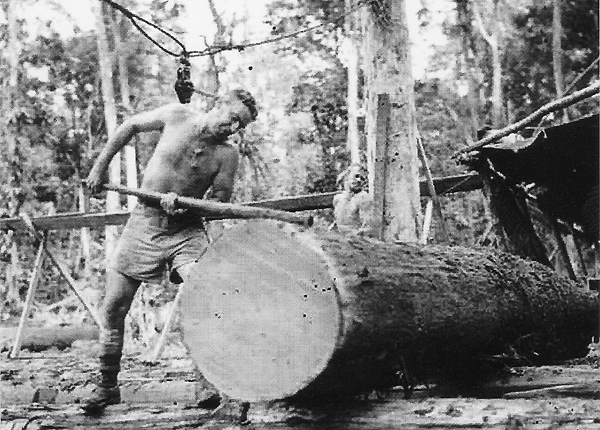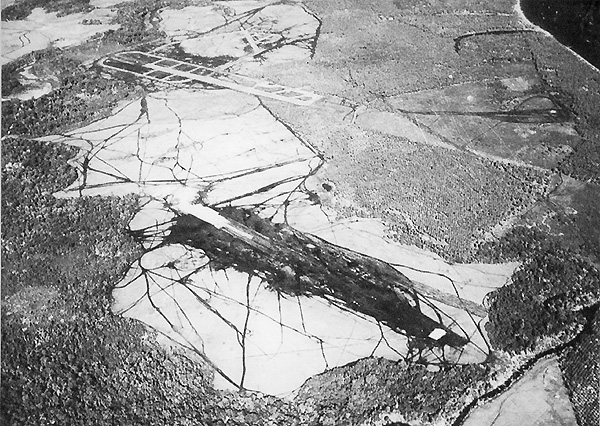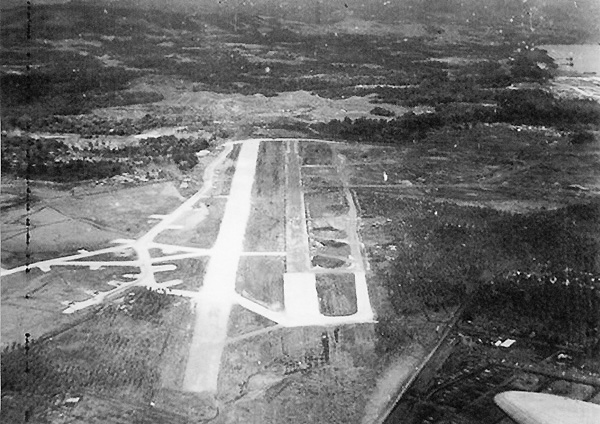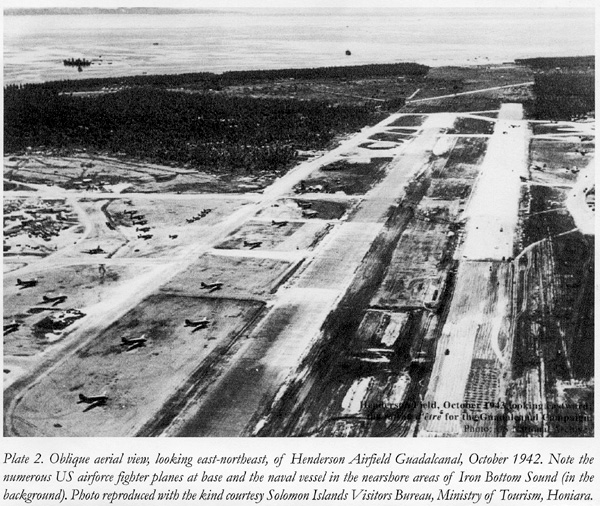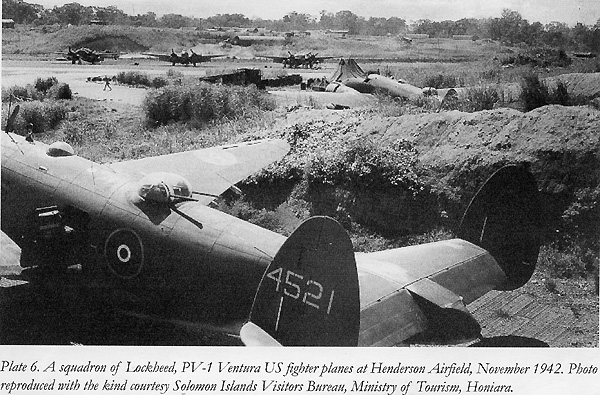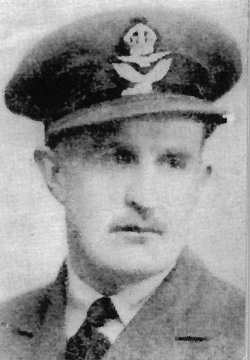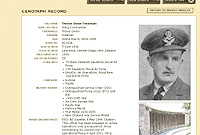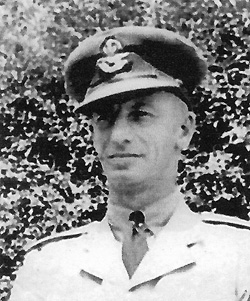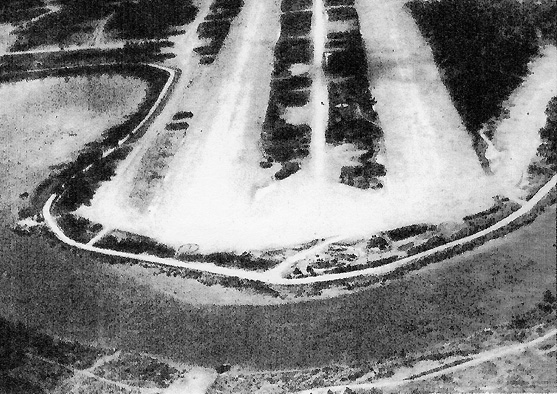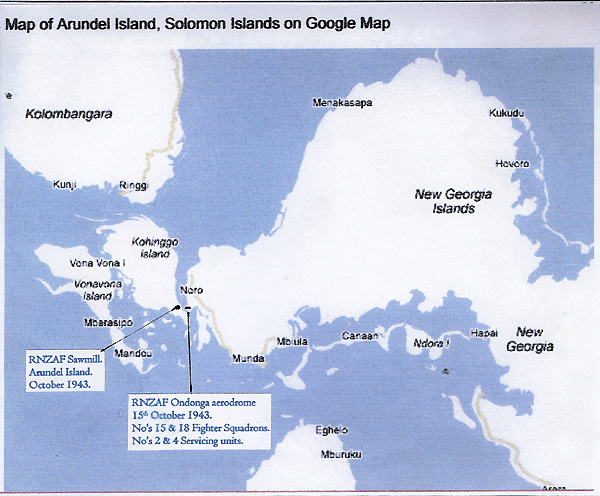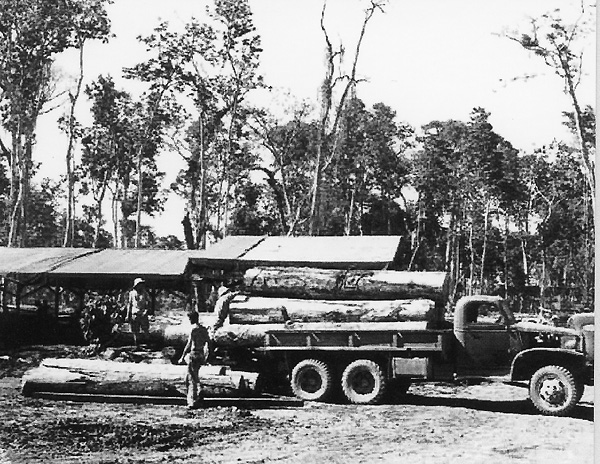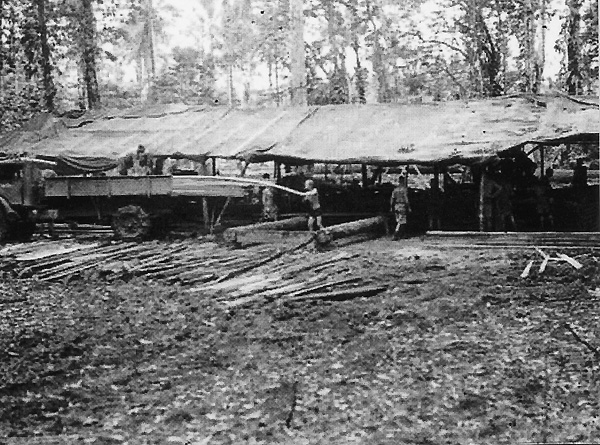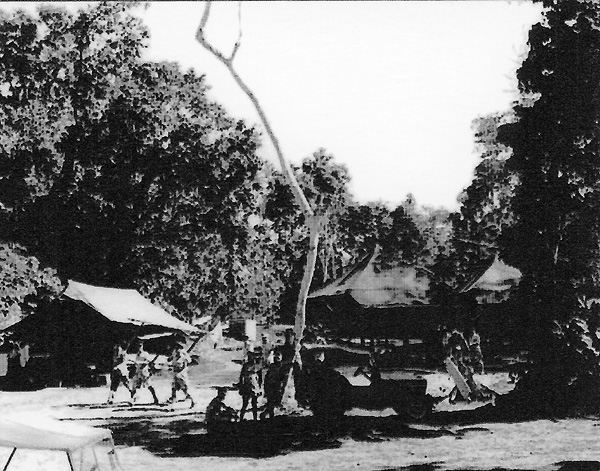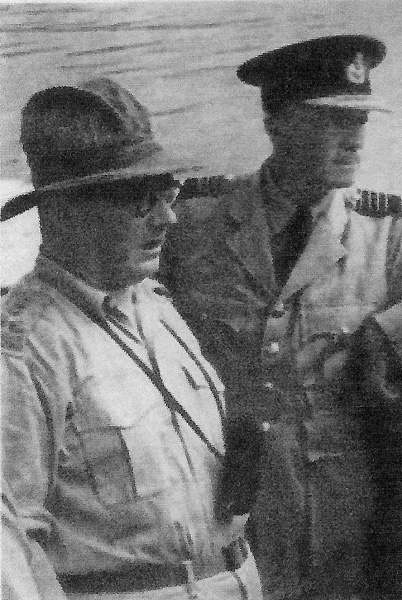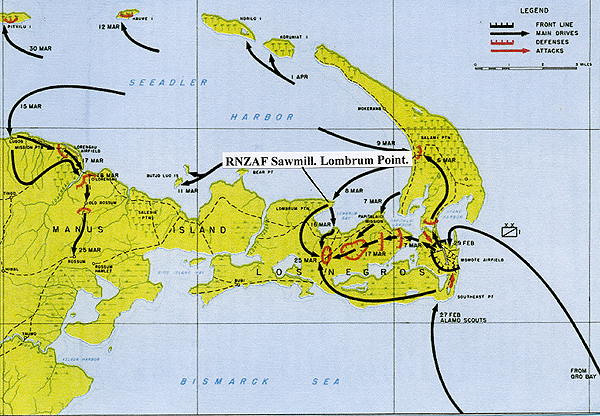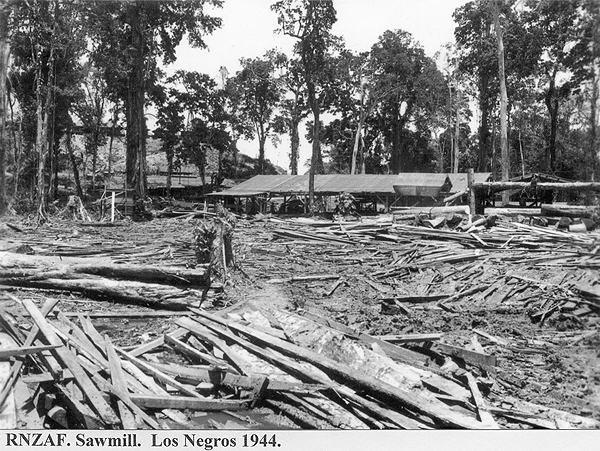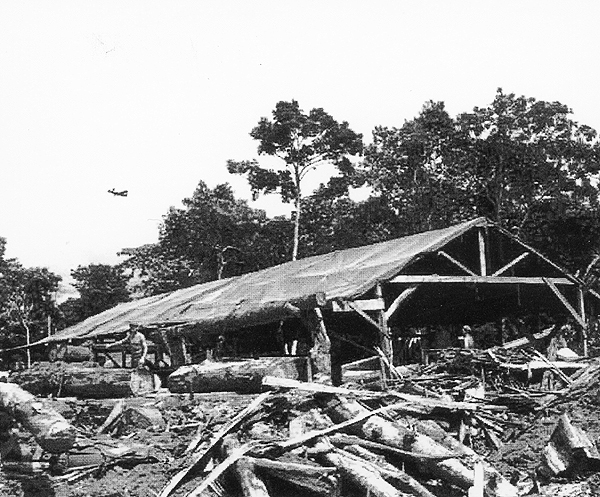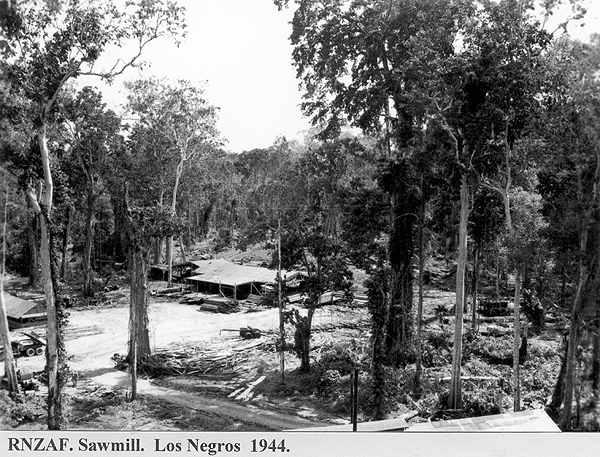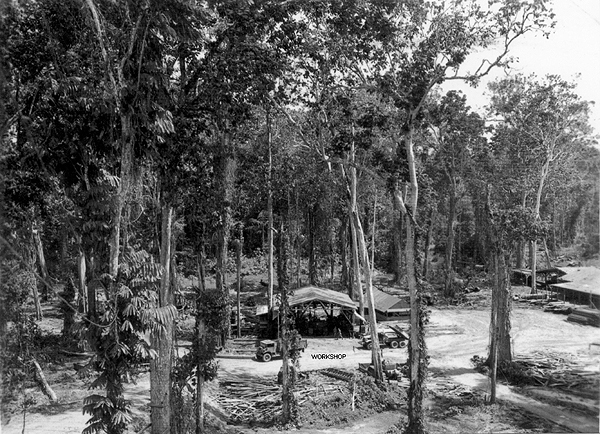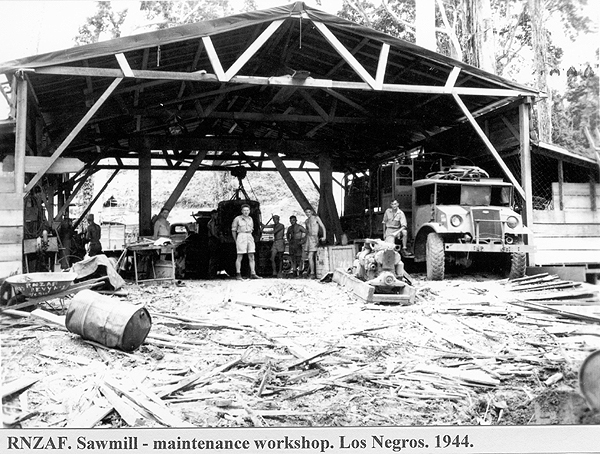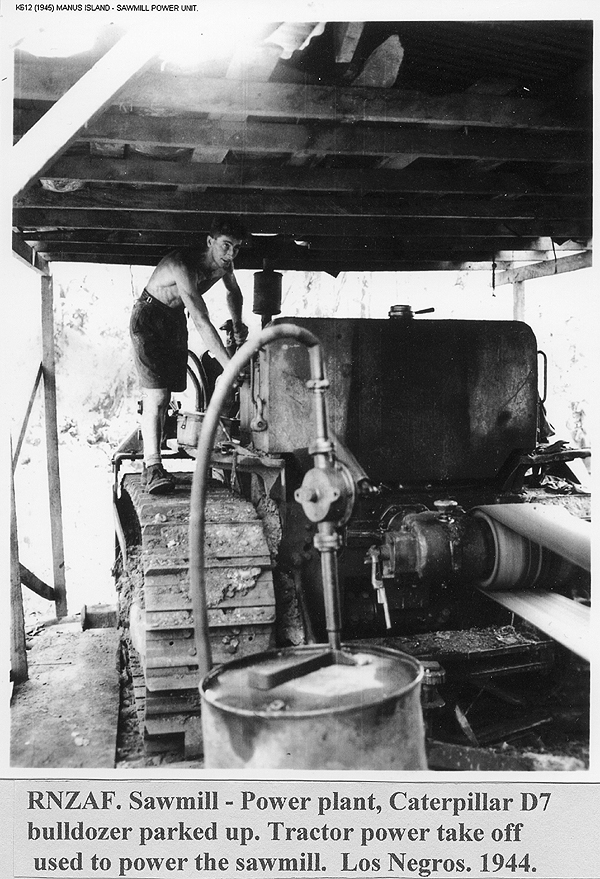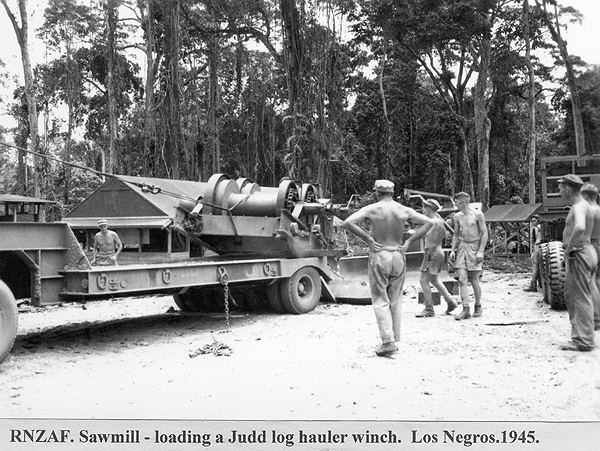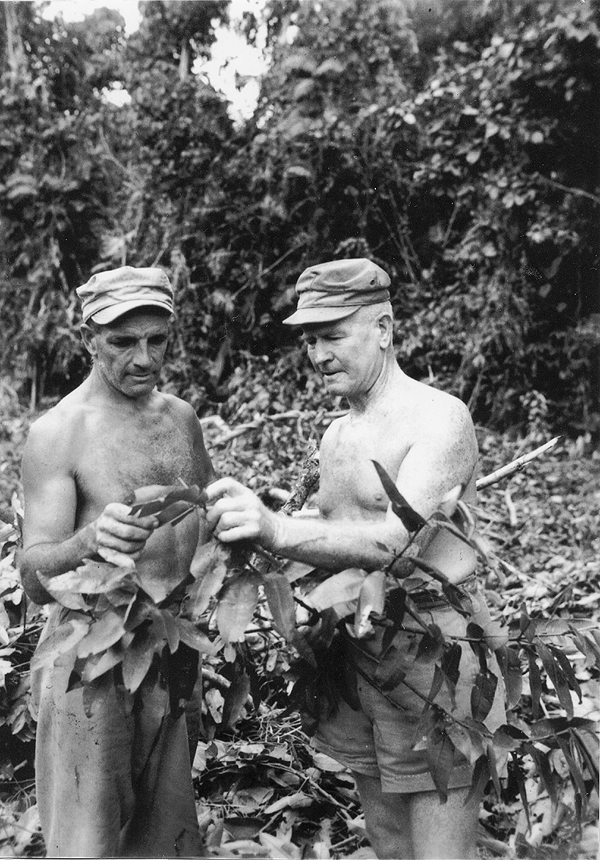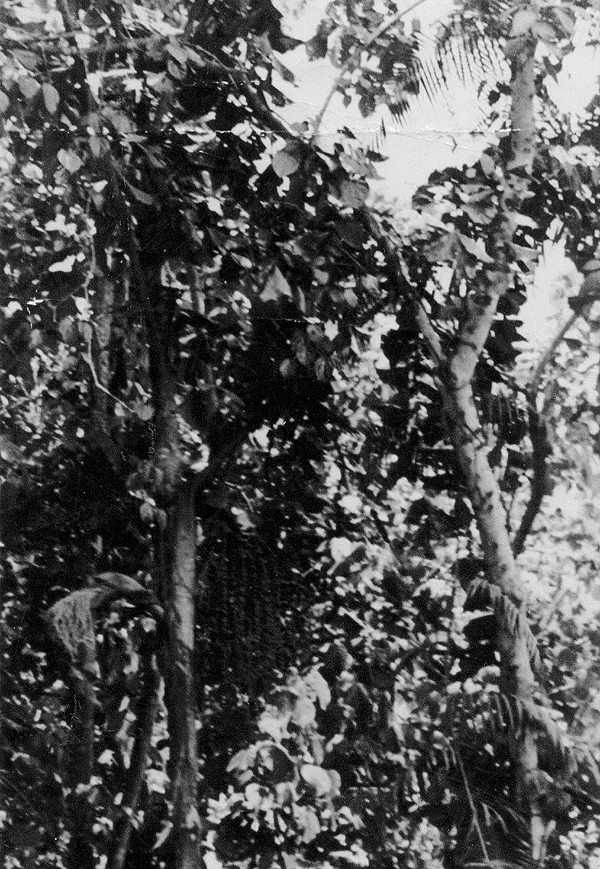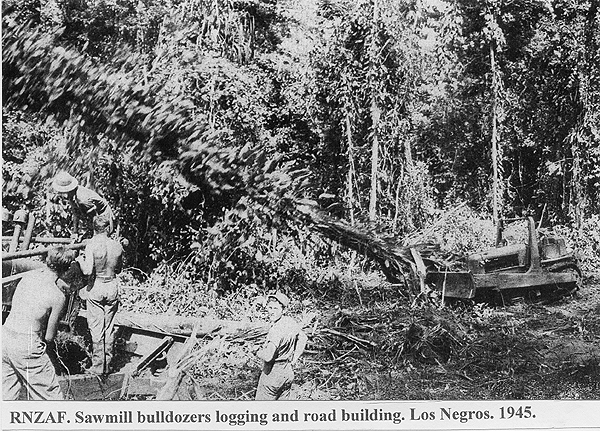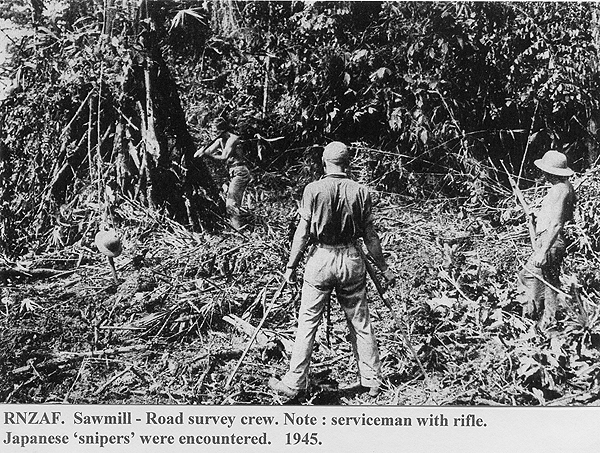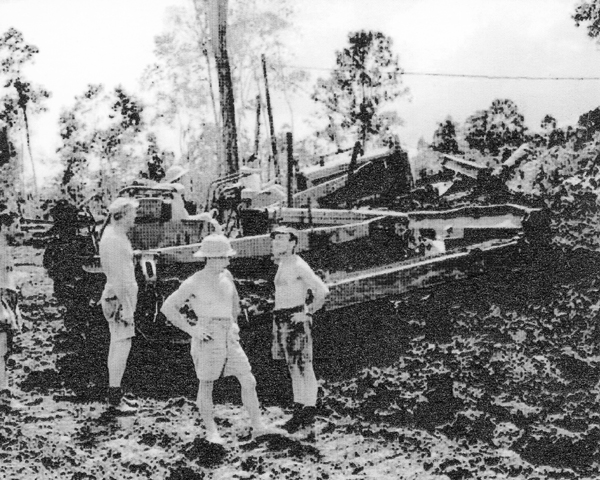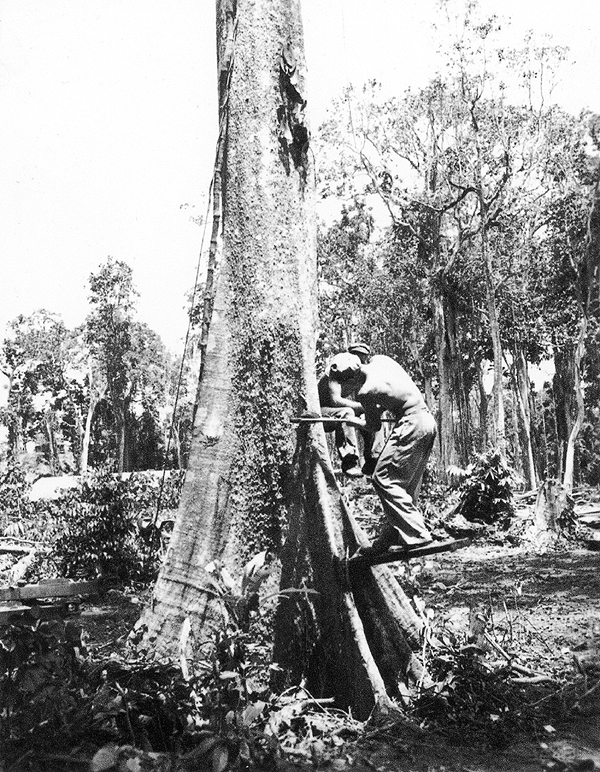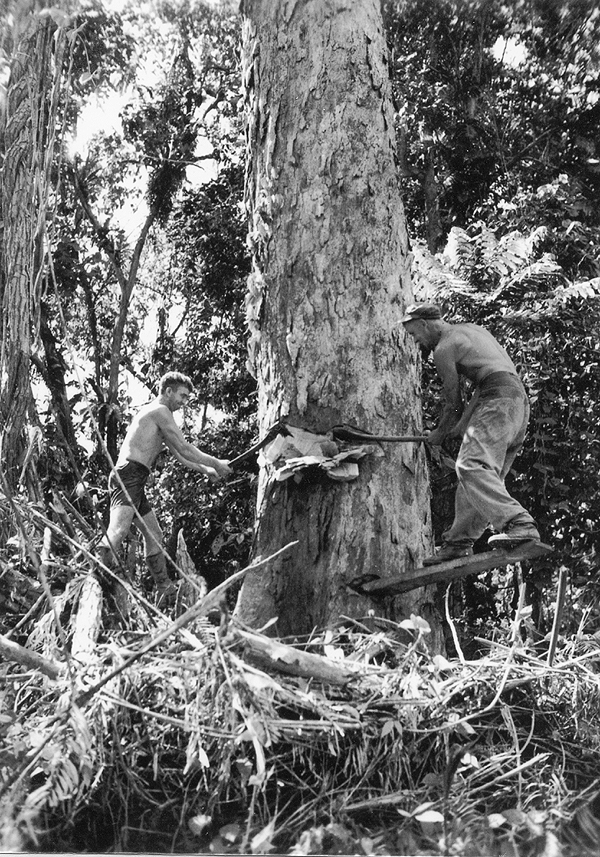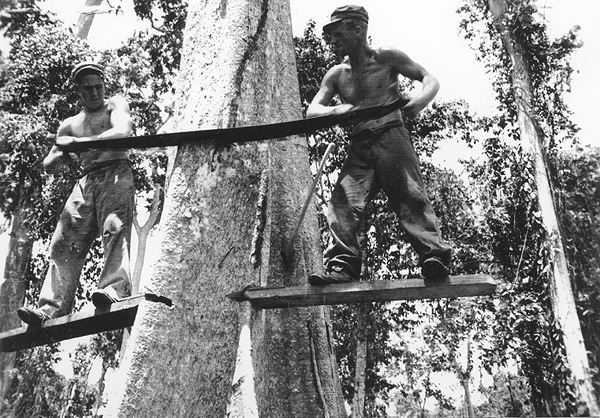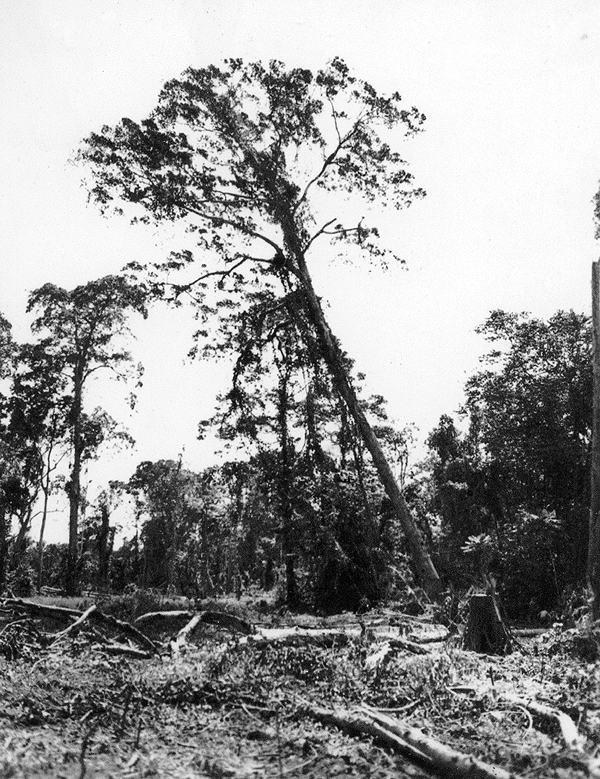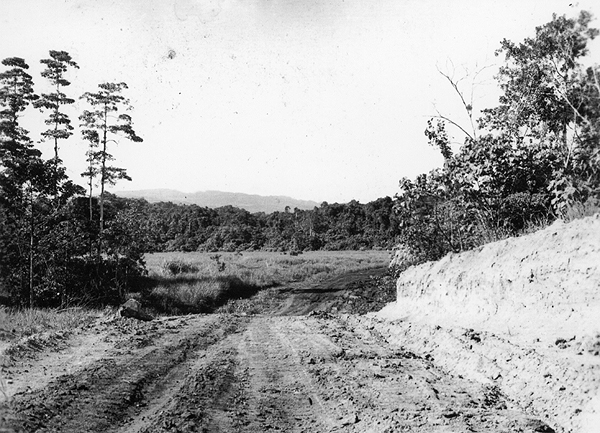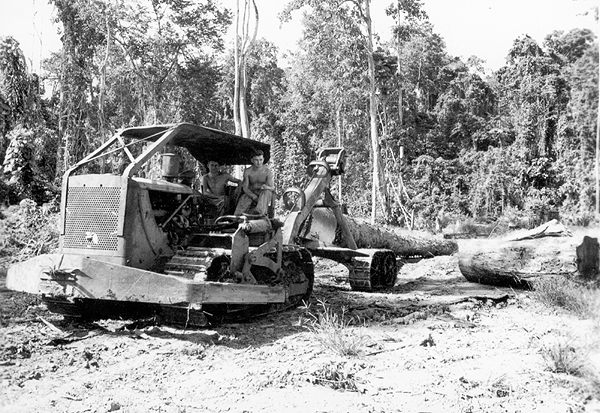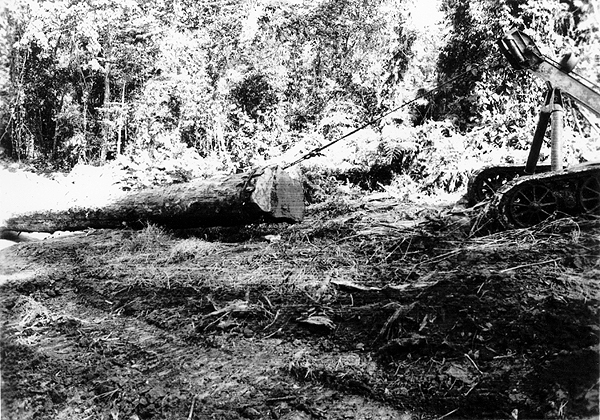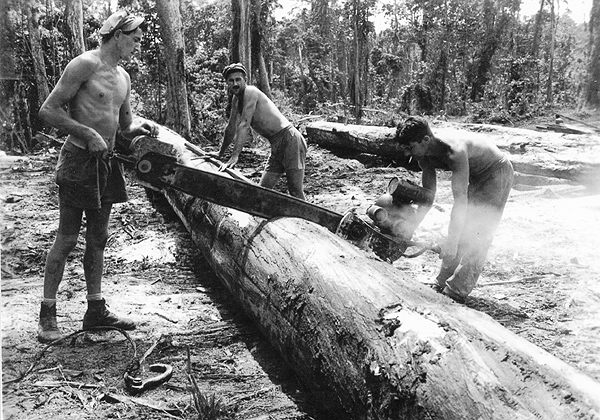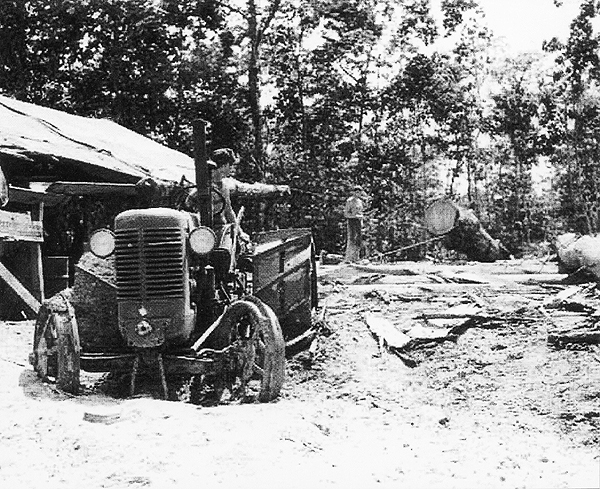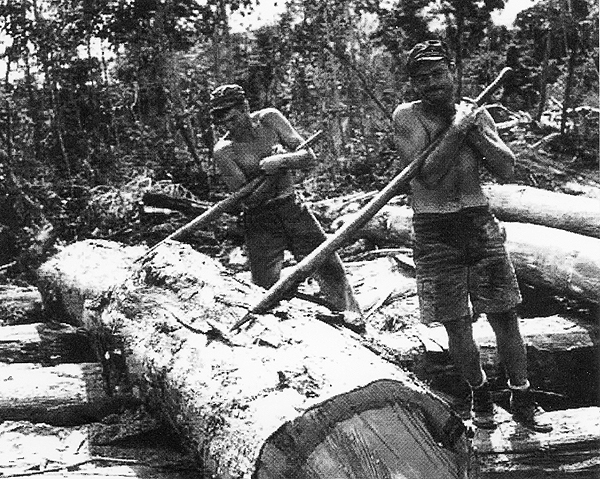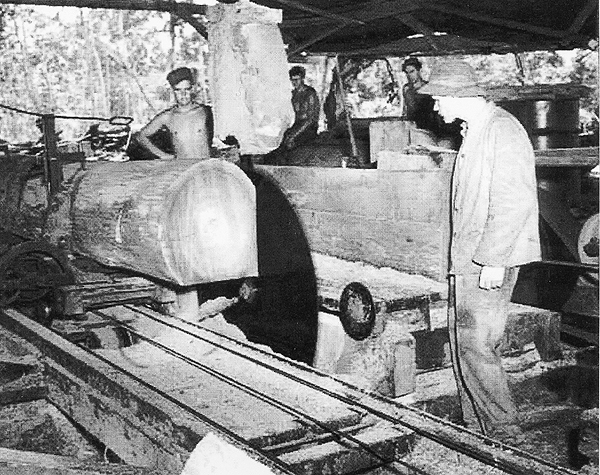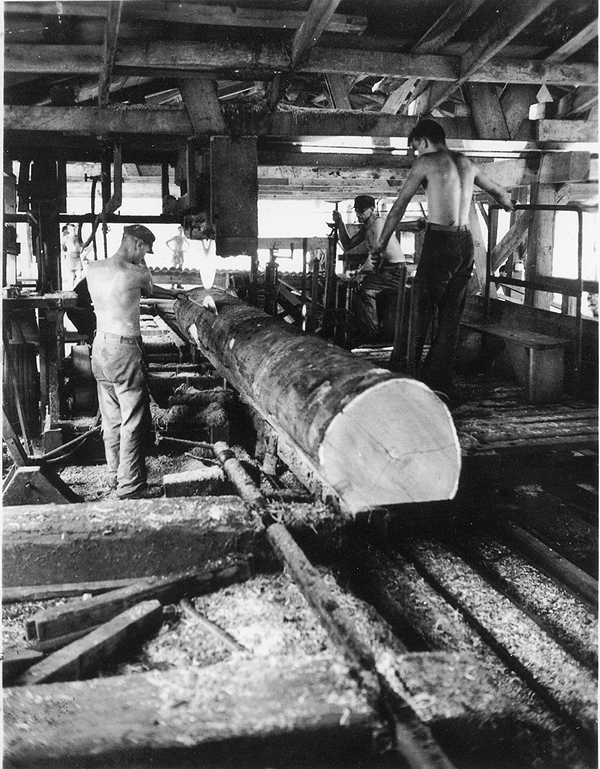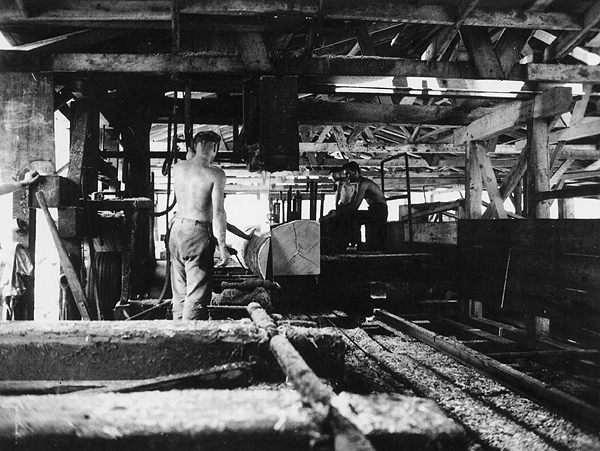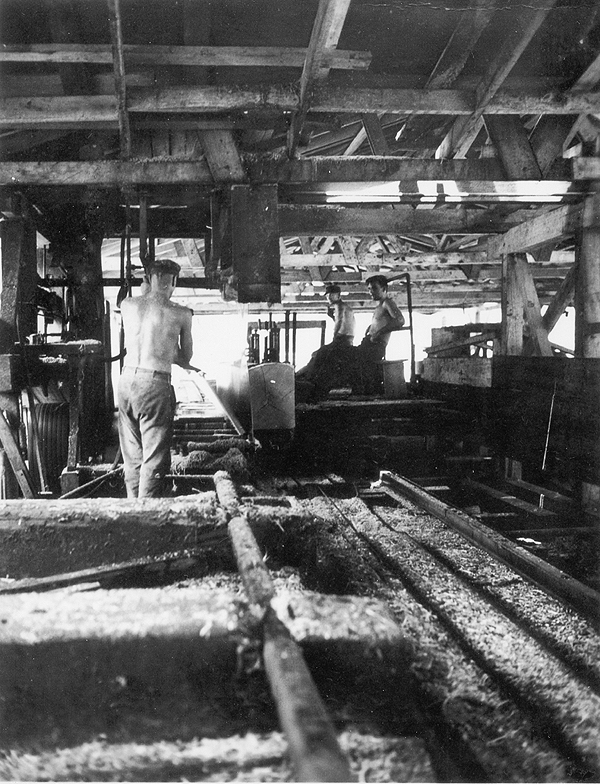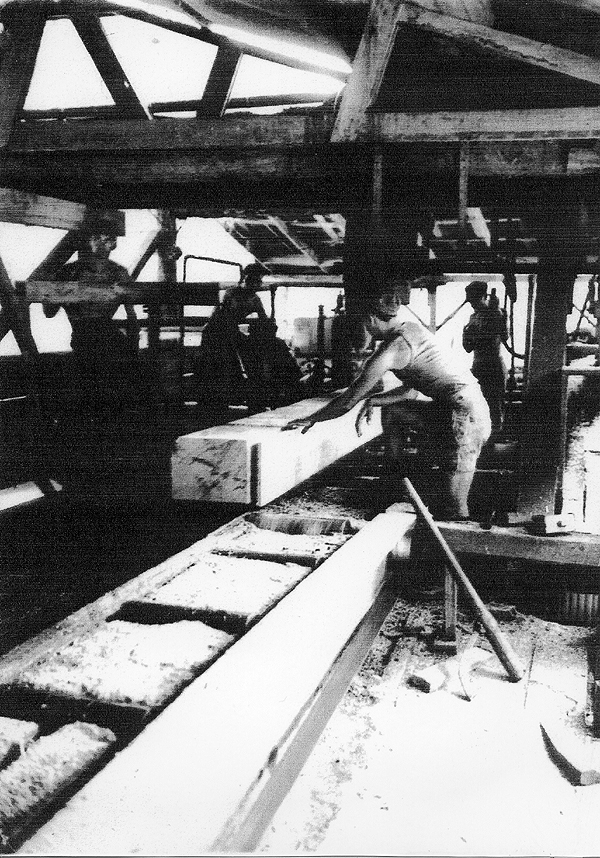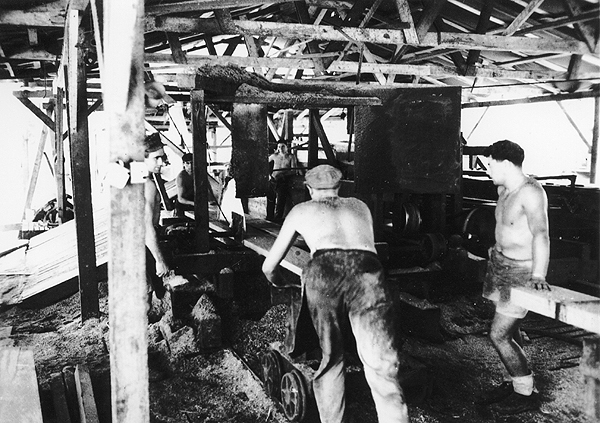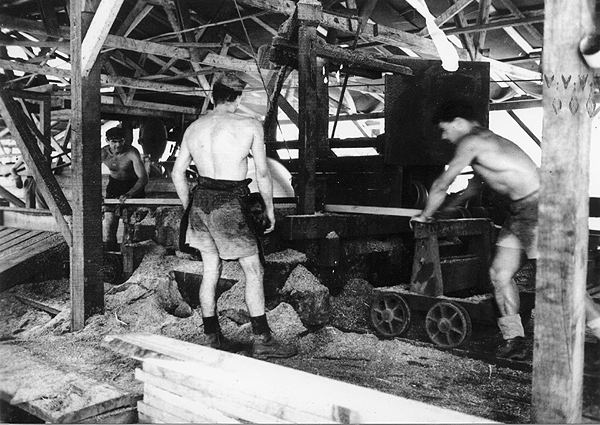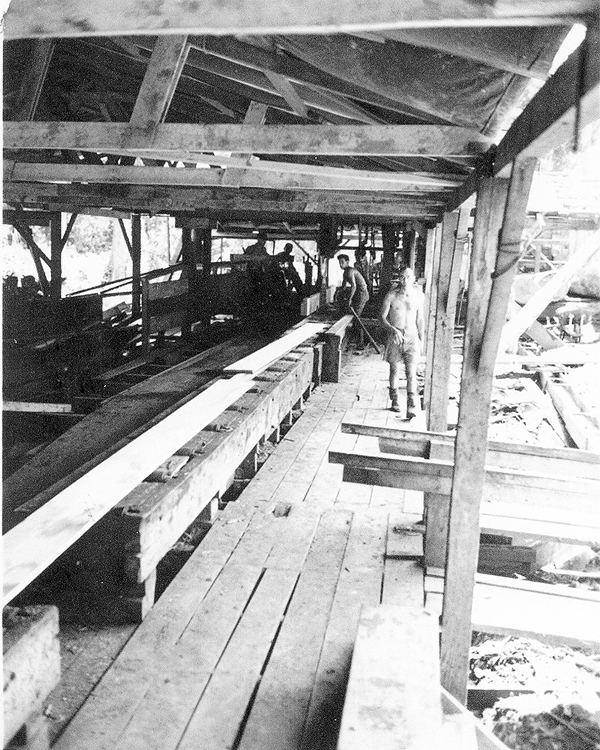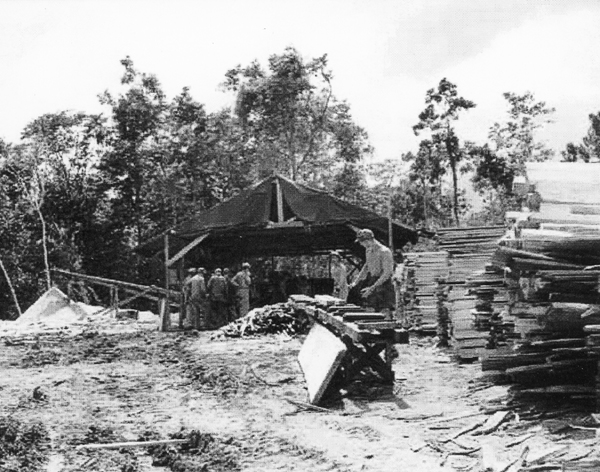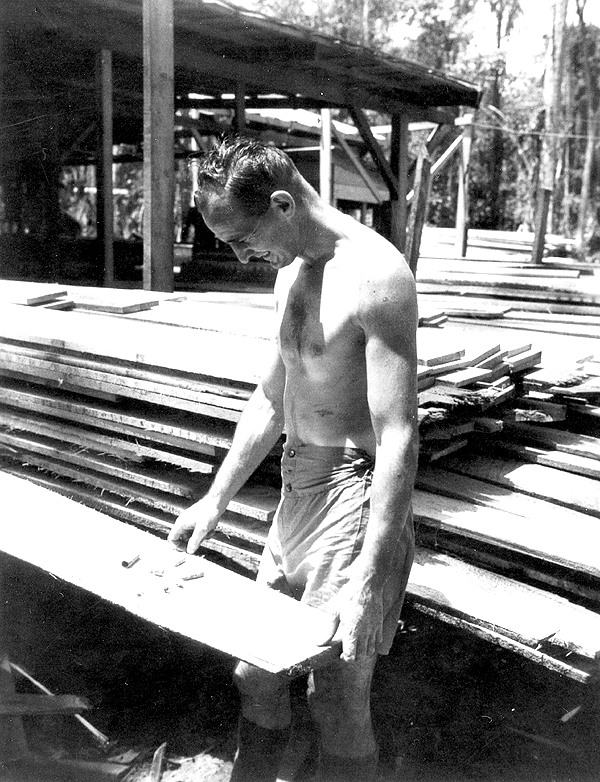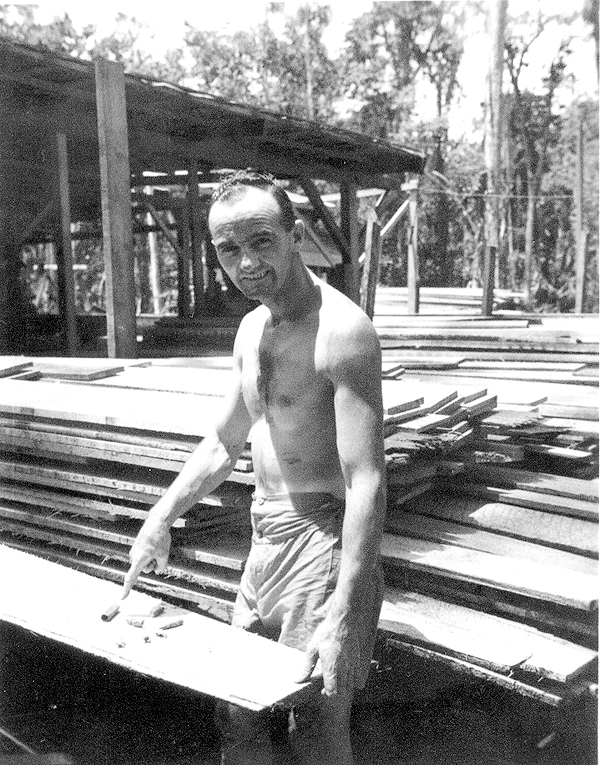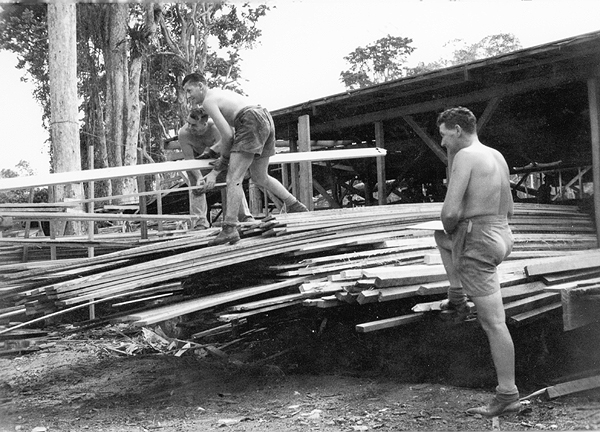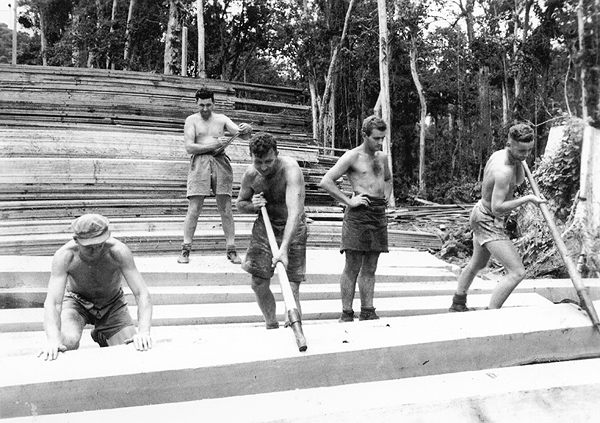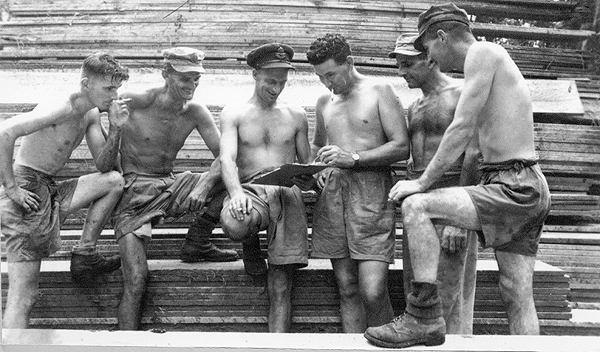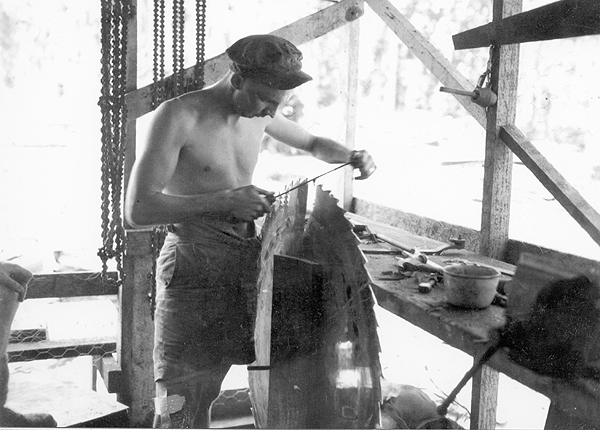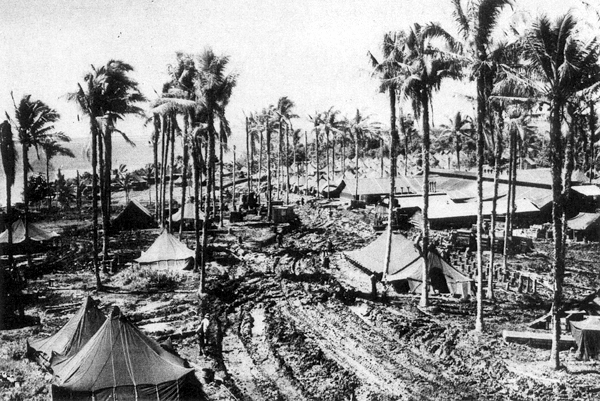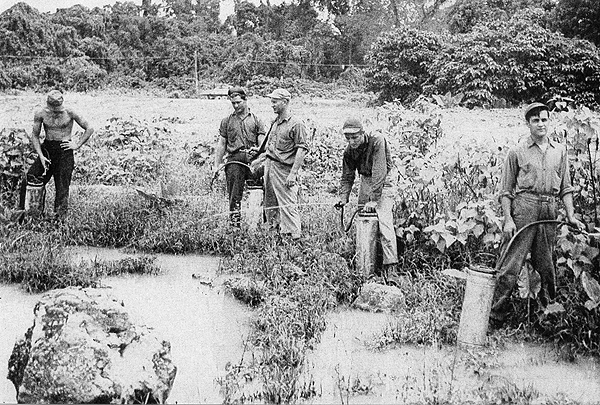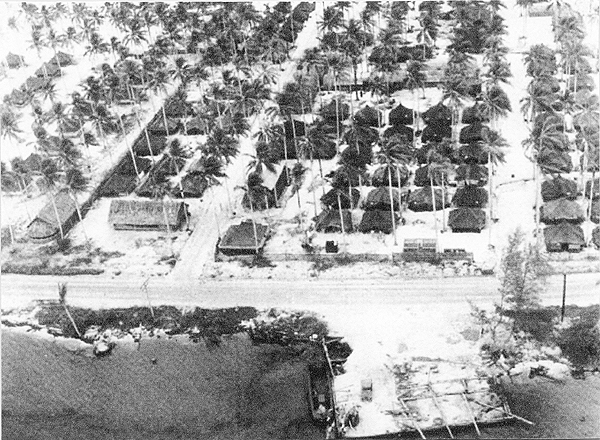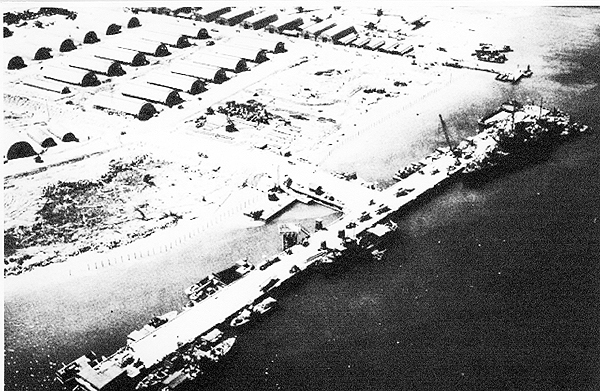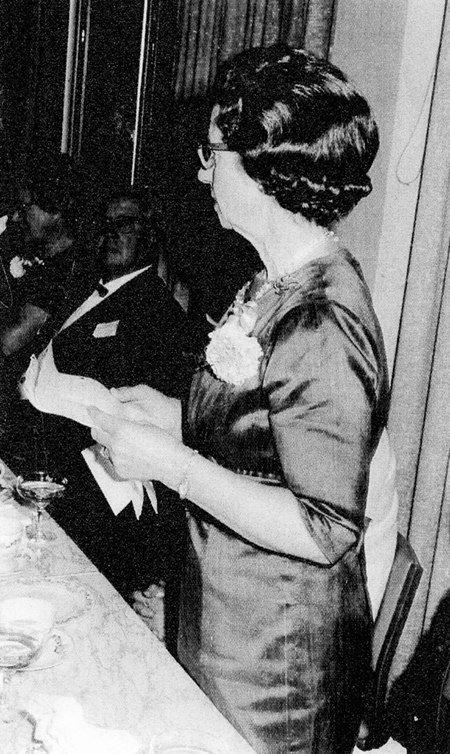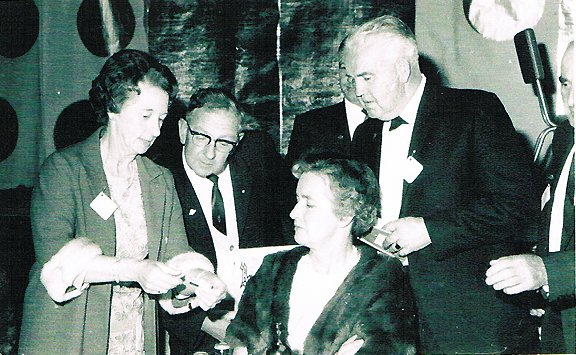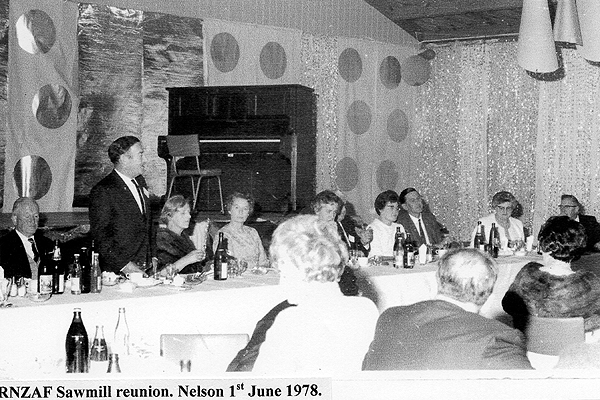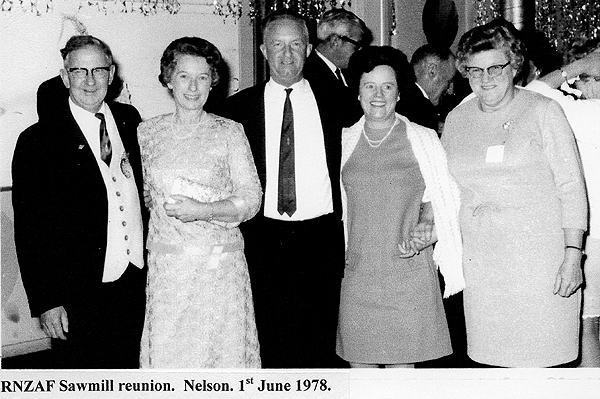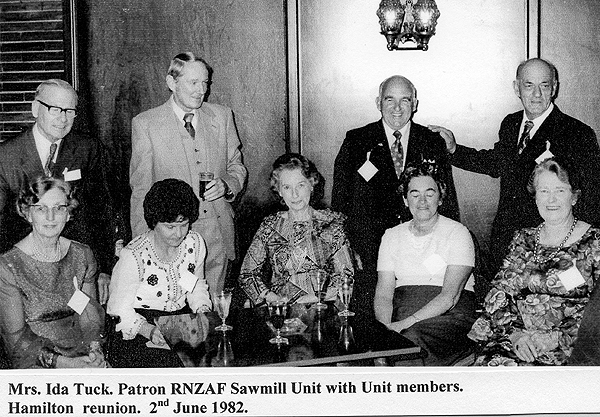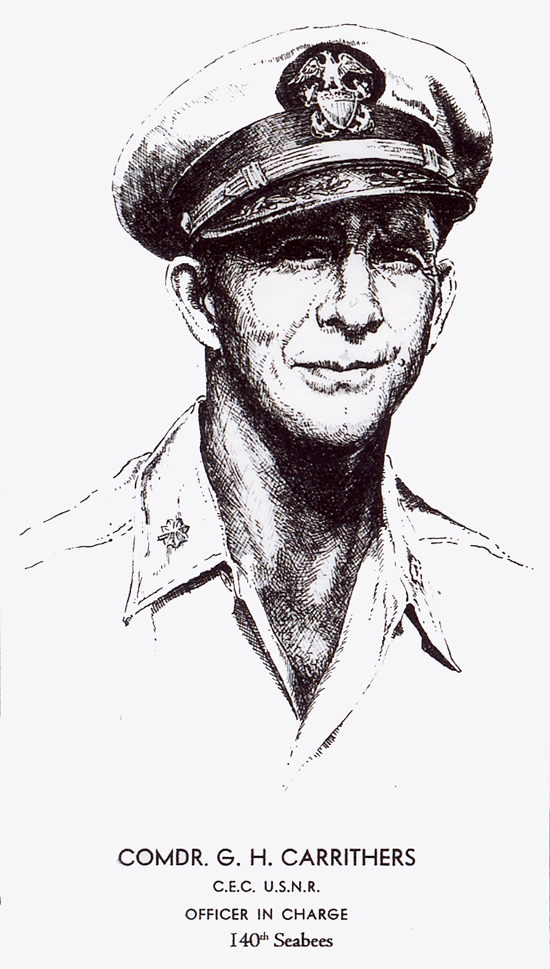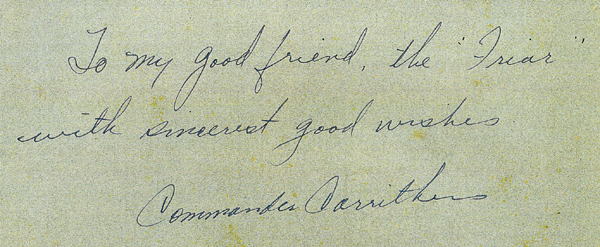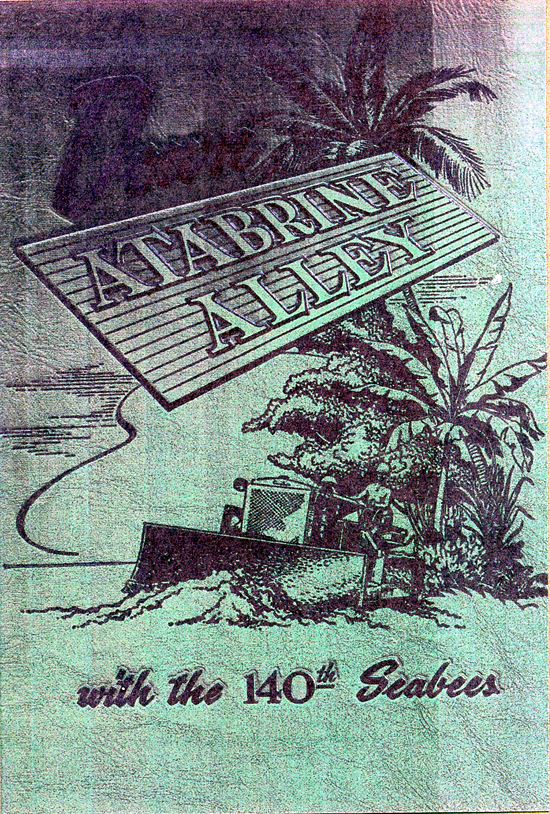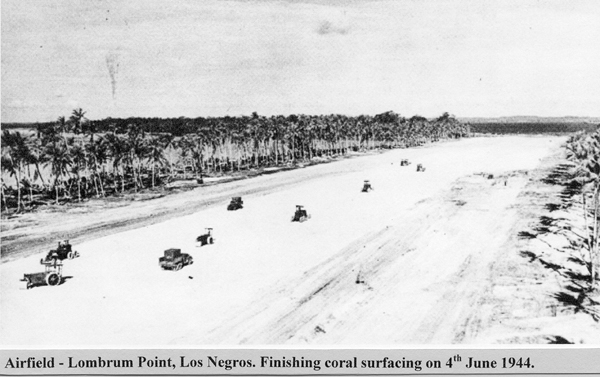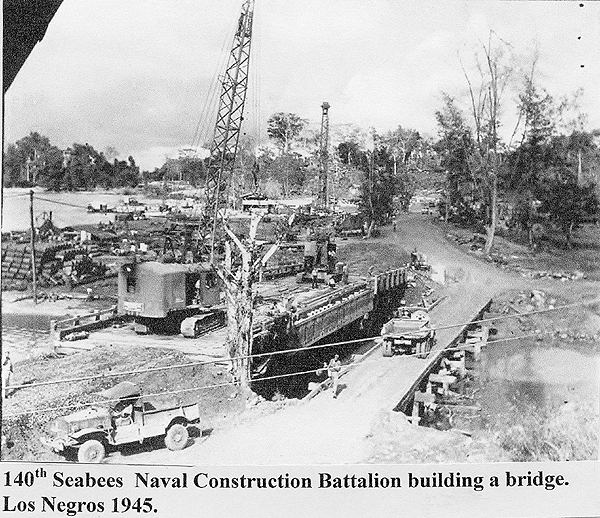A Wings Over Cambridge Special Presentation
No. 1 and No. 2 (Islands) Works Sawmill Units, RNZAFAnd their Commanding Officer Flying Officer Stanley Palmer Tuck (NZ1985)
The following history has been compiled by Michael Tuck of Onekawa, Napier. The story focuses on Mike's father's wartime service as the commanding officer of the RNZAF's sawmill units in the Pacific theatre of war. Mike has been trying to find a way to get this forgotten war story to a wider audience and so approached Wings Over Cambridge to see if it might fit in here. We're always happy to promote the RNZAF's WWII history and agree this forgotten chapter needs a wider telling, so here it is.
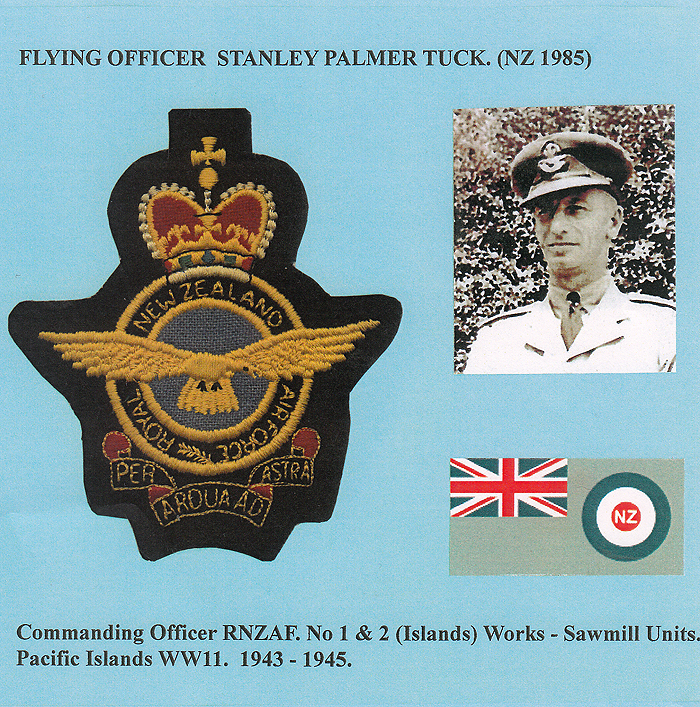
F/O Stanley Palmer Tuck
Known as Stan
Serial number RNZAF 1985
RNZAF Trade: Commanding Officer Sawmill Units. Pacific Islands
Date of Enlistment: 6th of October 1942
Date of discharge: 31st of October 1945
Rank : Flying Officer
Number of Tours : ThreeDate of Birth: 5th of December 1904 in Hampden (now Tikokino, Central Hawke’s Bay)
Personal Details: Stan was the son of John Thomas Tuck (JT) and Mary Alice (nee Gardner). JT was a sawmiller in partnership with Samuel Manson at Tikokino. (Manson & Tuck, 1899 to 1913). The company had three sawmills, and timber retail outlets at Waipawa, Hastings, Ahuriri, and Napier.
They imported and exported timber to Sydney, Australia from Napier. In 1908 before the Tikokino bush cut out, the company established two saw mills near Te Kinga, Lake Brunner, (Westland). The sawn timber was shipped to Wellington and Napier.
In 1914 JT bought a King Country farm, in the Taringamotu Valley, near Taumarunui.
Stan was educated at Te Kinga (Westland), Taumarunui, with a final year 1920 at Wanganui Collegiate, boarder Hadfield House. His interest included rugby and rowing. He served a Marine engineering cadetship with the Union Steam Ship Company, qualifying as a marine engineer, sailing mainly in the U.S.S. MV “Tofua”1, trading from NZ to the Pacific Islands.
Fiji 1924. Stan accompanied his father setting up two sawmills, Tavua, Viti Levu, and Buca, Vanua Levu.
JT’s interests were in prospecting for minerals which proved costly. JT arrived back in New Zealand early1929, Stan arriving later, married, and found work at Ellis & Burnand’s, Mangapehi sawmill. 1930 Stan moved to Hamilton, working for Aitkin’s Engineering Company, Frankton Junction. Depression years were tough, part of Stan’s work involved installing, and servicing milking machines in the Waikato area.
During 1931 - JT was mineral prospecting along the western side of the Kaimai Ranges, also looking for a block of bush to mill in the Central North Island. During 1935 he made arrangements with the widowed Mrs Mable Palmer, to rent her late husbands sawmill site at Oruanui . Stan and JT built a modern saw mill, based on the use of caterpillar tractor and logging truck, instead of bullock teams.
The company - Tuck Bros Ltd - started cutting timber at Oruanui mid July 1936 David Franklin Livingstone from Cambridge was appointed Secretary accountant. (David appears in Wings over Cambridge. RNZAF Fighter Ace.)
The company opened a timber yard and joinery factory at Morrinsville, Stan’s younger brother John Manson Tuck (Jack) appointed Manager. Jack lived in Hamilton, where he had rugby interests. (Waikato All Black 1929.)
When war was declared the Oruanui sawmill kept cutting until the younger men were called for military service, leaving JT to look after the mill. JT was forced to close the sawmill due to a shortage of workers.
The new Caterpillar RD8 bulldozer, tractors and vehicles were taken by the Government for war use.
Service Details
Pre-war: Territorial Army.
1940 Taupo Home Guard while waiting military call-up.
NZ Army - 1942. 1st Waikato Regiment, Ngaruawahia:
Lieutenant Serial Number. NZ 527909.
Royal New Zealand Air Force were looking for an experienced person to command their Pacific Islands sawmills. Lieutenant Stanley Palmer Tuck was transferred from the NZ Army to RNZAF on 3rd June 1943. Attended RNZAF course 52 at Omaka (Blenheim) Commissioned. Pilot Officer:
Serial Number. NZ1985.
Posted to Guadalcanal, RNZAF No1 (Islands) Works Squadron Sawmill Unit.RNZAF Guadalcanal sawmill was immediately upgraded increasing production. A second new sawmill had arrived from America, this was shipped to Arundel Island. for a short duration. There was an urgent need for timber on the newly captured New Georgia group of Islands. Arundel Island had a good stand of trees and was opposite the RNZAF Ondonga fighter airfield. Accessed by a causeway, timber was needed for building the RNZAF Fighter base at Ondonga airfield, and supplies to NZ Army and American Seabees construction units.
Timber shipped to units on nearby Islands, the allied invasion of Bougainville Island received 300,000 super feet of timber among the cargo following the landing, for construction of wharf, camp and bridge buildings. RNZAF Arundel mill produced 800,844 super feet of sawn timber in its few months of operation, it was then shipped back to Guadalcanal on 22nd May 1944. Now with the Japanese army driven further back, a site was selected, east of Henderson airfield, five miles up the Tenaru River. Named RNZAF No 2 Tenaru sawmill.
12th September 1944 : An American request for a RNZAF sawmill unit to operate their U S Navy sawmill at Lombrum Point, Los Negros, (Admiralty Islands.) The RNZAF formed a No 2 (Island)Works Squadron Sawmill Unit. The unit worked closely with the newly arrived U S Navy 140th Seabees Construction Unit. The two commanders had a lasting friendship. After the war , the 140th Seabees Commander Carrithers sent Stan a book recording their construction achievements. The cover is inscribed “To my good friend the ‘Friar’ with sincerest good wishes“ The American commander kept in touch with Stan’s Squadron reunions, for many years.
Promoted Flying Officer 25th October 1944.
Unit members acknowledged that their C.O. looked after them, was firm, but fair, they worked as a happy team, in dangerous situations. The units were stand alone, self contained, having to undertake all maintenance and repairs to machinery, tractors, and other transport, 80 percent of the airmen had no previous experience in sawmilling. Many of these service men came to work for Stan in his timber companies after the war.
Discharged to reserve 31 October 1945 during his third tour of duty to the Pacific Islands.
RNZAF Works Squadron Sawmill Units Reunions: March 1965-Stan attended the first reunion at Christchurch. Its success saw an agreement to hold future reunions bi-annually on Queen’s Birthday weekend at a pre-chosen NZ city or town. Stan died later that year. His widow Ida Margaret Tuck was asked to be the Squadron’s Patron. She accepted, attending all reunions and keeping up communications with the many members and their wives, until her death on 24th December 1999.
Following RNZAF Service : November 1945 - Stan returned to Oruanui, and reopened the mill (Tuck Bros Ltd, Oruanui) suppling sawn timber to the company’s Morrinsville Timber and Joinery Co, retail yard. Opened Taupo retail timber yard, planer machines, and a joinery factory, (Tauhara Timber & Joinery Ltd) Taupo engineering workshop. Late 1947, Stan designed and built a modern Native sawmill and staff housing at Tarawera on the Napier - Taupo Road. (Tuck Bros. Tataraakina Timber Co). Opening November 1948. To supply Napier yard.
Re-marrying in August 1949 he established his family home at Greenmeadows, near Napier. Late 1949 Napier retail yard was in the process of being built(Tuck Bros Napier Ltd) with modern planing and moulding machines. 1951 Tuck Bros bought Taupo Sawmills Ltd. 1952 Tuck Bros Ltd secured the cutting rights to the 25,000 acre Tauhara Radiata Pine Forest, and built a modern sawmill in Taupo with machinery specially to cut Radiata Pine logs.-Tuck Bros (Exotics) Ltd, Tanalith and Boric timber treatment plants built to process the radiata timber.
Pre-cut homes factories established, Taupo and Napier using planer gauged radiata pine treated timber in their pre-cut homes buildings. November 1957 Stan established the log trade to Japan, exporting Radiata logs from Tauhara Pine Forest, through the Ports of Mount Maunganui and Napier, 1959.
Fletcher Timber Co bought all the Tuck Bros, timber interests and companies in June 1960.
Taradale Hawke’s Bay 1961. Stan established two companies.- Tuck Automotive & Industrial Engineering Ltd. Purchased G & C Wood Ltd, a trucking company with valuable service licences. Added to this company was a shingle plant and earthmoving machines enabling the company to carry out many road contracts in the Hawke’s Bay region.
Stanley Palmer Tuck died in his 60th year on 11th October 1965. Buried, Taradale Cemetery. Napier.
Footnote: This account compiled by son Michael Palmer Tuck.
For my pilot medical renewals, Dr. Sam Turner was the accredited CAA medical practitioner for Napier. The Dr had been one of the RNZAF Pacific Islands Medical Officer. He circulated round calling on RNZAF camps. He would tell me how he enjoyed calling on my dads camp. “Never any trouble there, made my job easy. Stan ran a great camp. Looked after the men.” Meanwhile thinking about myself and how was my medical going! - When reaching for the door handle to leave, the Doctor would say “by the way you passed”
(Researched & upgraded by Michael Palmer Tuck. August 2012.)________________________________________________________________

No. 2 (Islands) Works Squadron, RNZAF, Sawmill Unit - Manus Island, September 1945
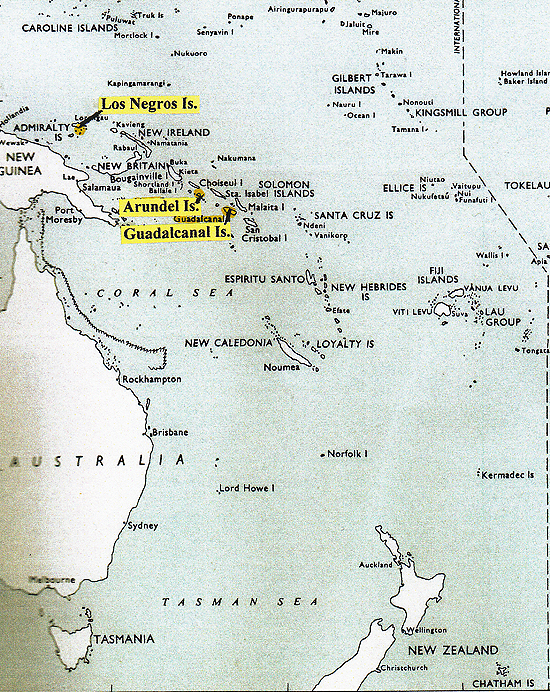
Pacific Islands where the RNZAF Samills were established 1943-1945, WWII
Guadalcanal (Solomon Islands)
No. 1 (Islands) Group, RNZAF
Sawmill Unit arrives from New Zealand 7th of February 1943

Guadalcanal. Below a closer look at the area where the Sawmill was established
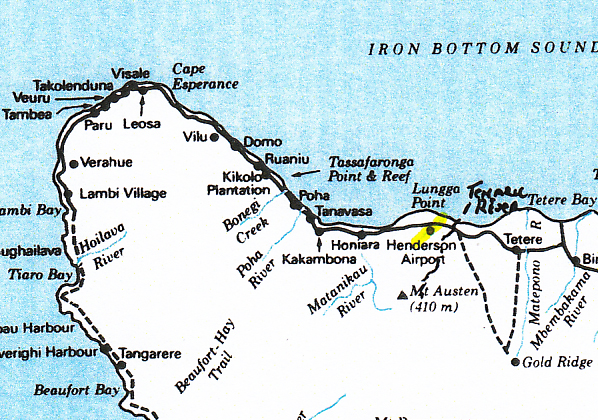
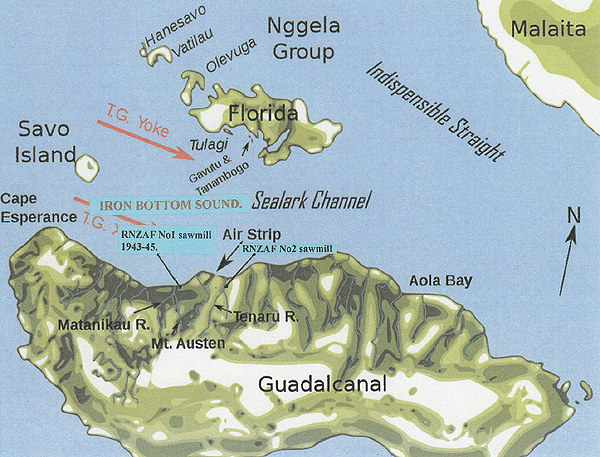
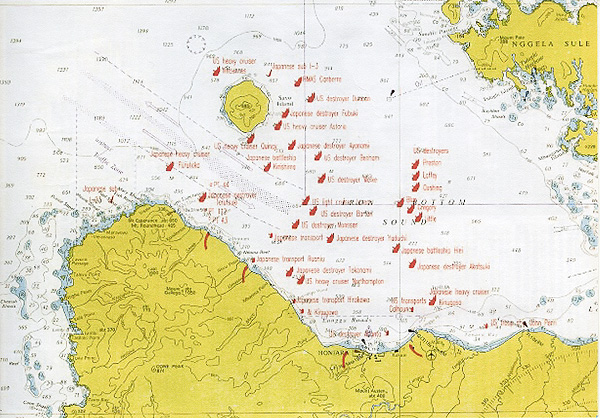
Iron Bottom Sound, Guadalcanal
Guadalcanal
RNZAF despatched a flight of six Hudson Bomber from No 3 Squadron, on 23rd November 1942 to Henderson airfield Guadalcanal. - a request by the American Forces for reconnaissance patrols. No 3 Squadron set up their tent camp in the jungle near to the airfield. They were reliant on the American Forces to provide all there needs.
The RNZAF had no intention that any works personnel should be sent from New Zealand.
When the Americans could no longer help in bringing the New Zealand camp up to the required standard, or provide aircraft servicing, it became necessary during 1943 to send works personnel to the Pacific Islands.
On 7th February 1943, an RNZAF party of fifty men under the Command of Flying Officer W. E. Puddy arrived at Guadalcanal by ship from NZ. The party consisted of tunnellers, bushmen, carpenters, tractor drivers and men in other similar trades. A small sawmill plant was included to enable the unit to mill its own timber. The mill was established with great difficulty, about half a mile from the coast up the Mataniko River, near Kukum. The mill was powered by a captured Japanese ‘Hino’ 130 hp diesel Half Track personal carrier.
In June 1943 one hundred more RNZAF works personal were sent to Guadalcanal and Santo to assist in construction and maintenance work and in particular the construction of buildings.
At the end of 1943 a unit known as No1 (Islands) Works Squadron was formed within No1 (Islands) Group. The newly named RNZAF No1 (Islands) Works Squadron with detached Flights, (also called Units) of up to 100 men now became responsible for all the RNZAF’s camp constructions. This required an increase in timber production. The RNZAF were looking for an experienced person to command their sawmill units.
Lieutenant Stanley Palmer Tuck, a saw miller, was transferred from NZ Army to RNZAF on 3rd June 1943. Attended RNZAF course 52 at Omaka (Blenheim) Commissioned and posted to Guadalcanal, RNZAF No1 (Islands) Works Squadron Sawmill Unit.
The original RNZAF, sawmill known as RNZAF No1 sawmill, was updated in November 1943 with American sawmill machinery, the captured Japanese power plant scrapped, and replaced with a heavy duty marine diesel motor. Timber production increase to a daily average of 8,500 super feet. The Japanese now driven further back on the Island, enabled a more suitable selection of logs, later taking in the area from the coast back to Mount Austen.
RNZAF No 2 Sawmill arrive at Guadalcanal, during November 1943. It was shipped on to Arundel Island also known as (Kohinggo Island.) on the west side of Noro Passage - New Georgia Islands Group. This group of Islands had recently been captured, timber was urgently needed for building camps, bridges, and wharves. The Arundel mill, from November 1943 to May 1944 produced 800,844 super feet of timber. When no longer needed, the mill was shipped back to Guadalcanal and set up to the east of Henderson Airfield, about five miles up the Tenaru (or Llu) river. Named, RNZAF No 2 (Tenaru) sawmill. RNZAF military sawmilling ceased production at Guadalcanal mid March 1945. Other sawmills had been set up closer to the forward areas. The RNZAF mills at Guadalcanal had produced through No 1 sawmill about 2,635,749 super feet, and No 2 set up August 1944 to March 1945, produced 1,475892 super feet.
May/June 1945 the RNZAF No 2 Tenaru sawmill was shipped to Polmalmal, near Jacquinot Bay, New Britain. RNZAF Guadalcanal sawmill crew, that had not completed their 12 months overseas service were transferred to RNZAF No 2 (Islands)Works Squadron sawmill unit at Los Negros, (Admiralty Islands). This established US Navy sawmill on Lombrum Point Los Negros, was handed over to the RNZAF for the use of the RNZAF sawmill personnel. RNZAF operated this sawmill from the 12th September 1944 till wars end, August 1945.
Above: General view of the sawmill through gap in the dense bush. RNZAF Official, Air Force Museum of New Zealand (PR2619)
Sawmill workers remove logs with a crawler tractor. Guadalcanal. RNZAF Official, Air Force Museum of New Zealand (PR2621)
Workers rolling a log onto skids before its journey through the sawmill, Guadalcanal. RNZAF Official, Air Force Museum of New Zealand (PR2608)
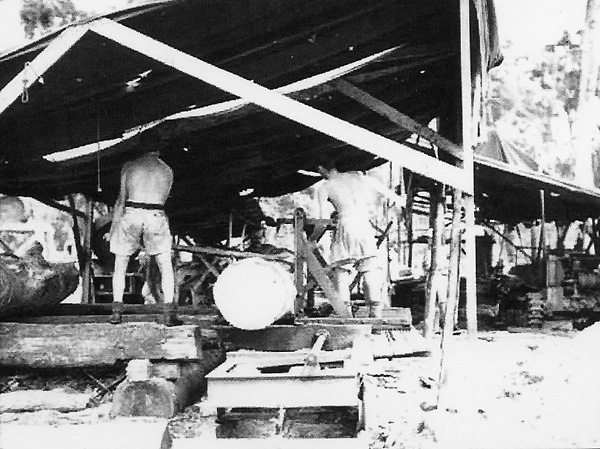
Royal New Zealand Air Force timber mill in operation, by No. 1 (Islands) Works Squadron
RNZAF Official, Air Force Museum of New Zealand (PR1285)
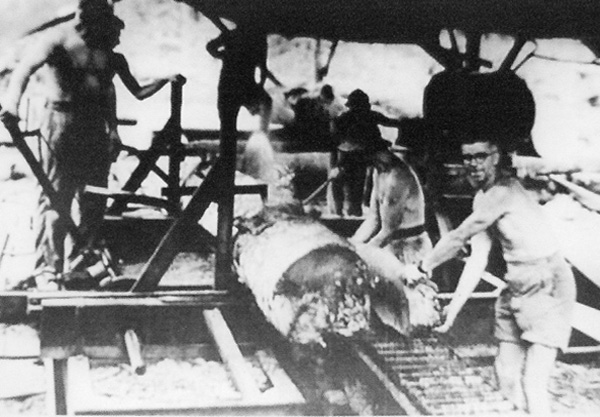
The small sawmill that arrived with the first RNZAF Works Unit in February 1943.
Powered by a captured 130hp Japanese half track personnel carrier
Guadalcanal March 1943
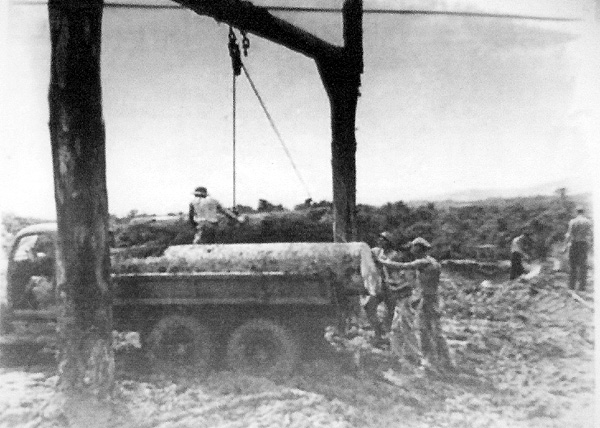
RNZAF Sawmill servicemen loading logs inside the 'perimeter'. Japanese
Army were still active in the vicinity. Coastal Guadalcanal, near Matanikau
River, 1943
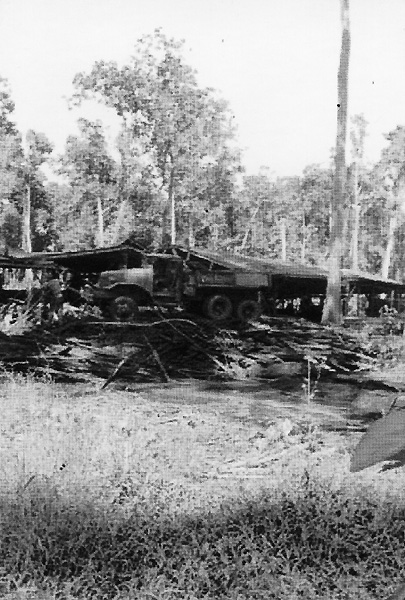
General view of the sawmill on Guadalcanal, 1945
RNZAF Official, Air Force Museum of New Zealand (PR5860)
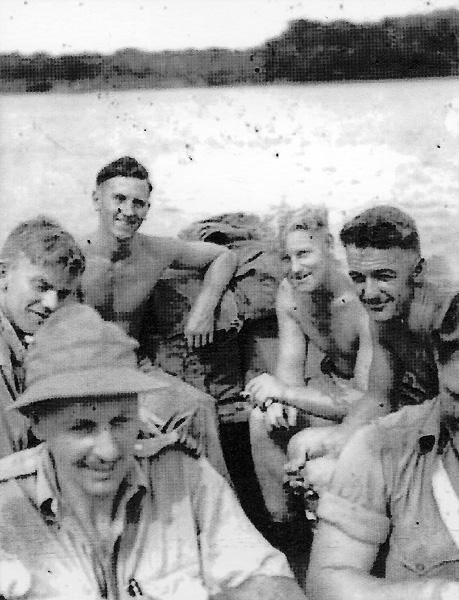
Sawmillers going to camp for supplies. Possibly Guadalcanal or Arundel Island
RNZAF Official, Air Force Museum of New Zealand (PR2610)
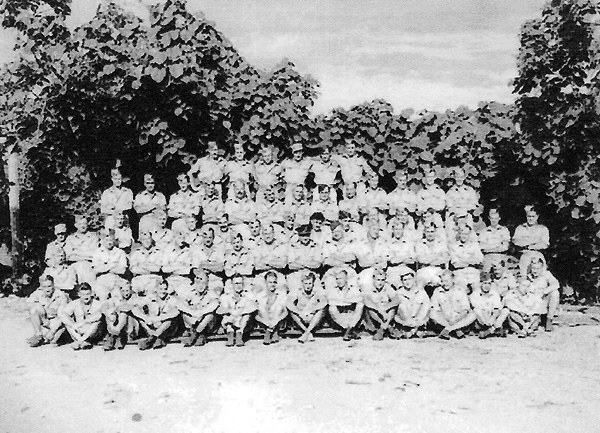
Group of No. 1 (Islands) Works Squadron personnel, Gudalcanal, 1945
RNZAF Official, Air Force Museum of New Zealand (PR6101)
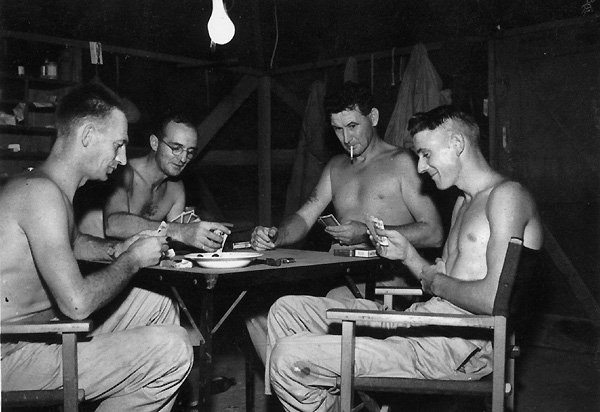
RNZAF Sawmill Unit members, Guadalcanal, 1943
Left to right - F/O Stan Tuck, CO: unknown, Jack White, Ben Thomas
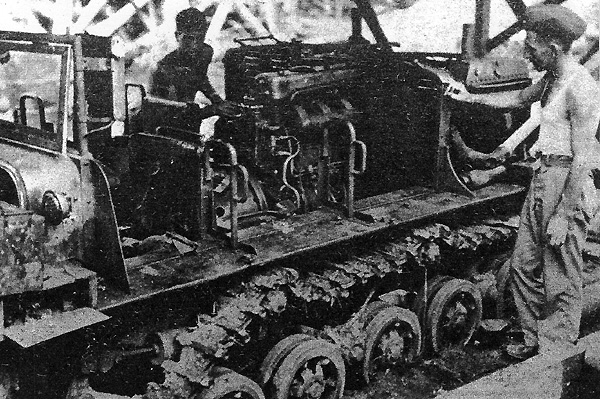
RNZAF Sawmill powered by 130hp captured japanese diesel 'Hino' halftrack
personnel carrier, Model 98. February 1943

Type 1 Ho-Ha Halftrack Armoured Personnel Carrier
History: Japanese Halftrack Armoured Personnel Carrier Tpye 1 HoHa Model 98.
Similar to the German Sdkfz 521/1 Hanomag halftrack.
Japanese Type 1 Ho-Ha Model 98 halftrack was first manufactured 1941 by Hino Motors. Built on 6.1 metre chassis - a pair of steering road wheels attached to the front, with short caterpillar tracks at the rear.
Engine: Hino 6 cylinder air cooled 130hp side mounted
Weight: 6.5 tonnes
Range: 300 kilometres
Speed: 50 km/h
Armament: Three 7.7mm Type 97 light machine guns. One on each side just behind the driving compartment, third gun mounted at rear as an anti-aircraft gun.
Fitted with towing gear to tow heavy guns.
Disadvantaged by having an open top. Crew/troops were vulnerable, especially to grenades, high explosive rounds and shrapnel
Gaudalcanal. The Japanese were constructing original airfield when captured by American forces on 7th of August 1942. In the background is Henderson Field constructed by Americans. Photo taken November 1942.
Henderson Field, Guadalcanal. March 1943
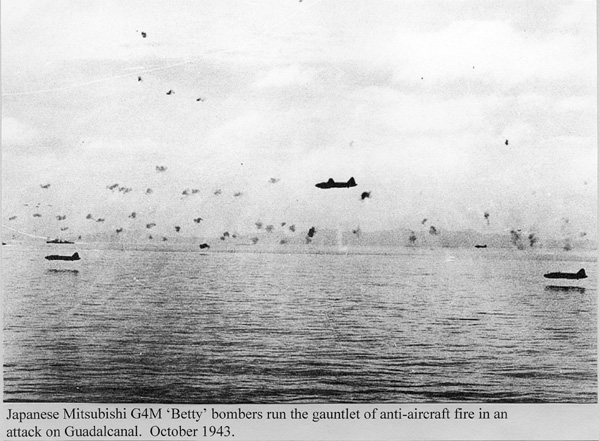
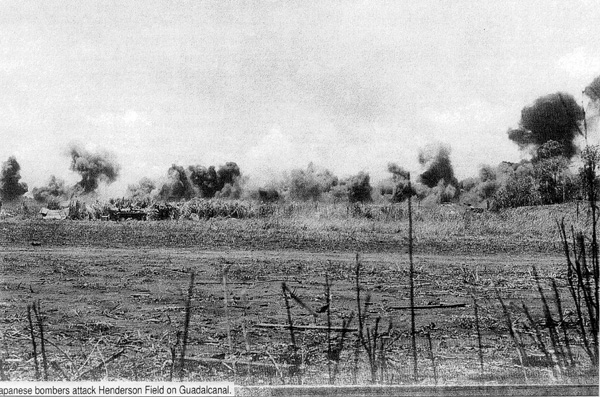
New Georgia
Arundel Island (Solomon Islands)
RNZAF No. 1 (Islands) Works Squadron. SAWMILL UNIT
2nd November 1943RNZAF Station New Georgia - On the 15th of October 1943, RNZAF Station New Georgia was formally established at Ondonga.
WingCommander Trevor Owen Freeman DSO, DFC, and bar, was appointed over-all Commanding Officer.
Wing Commander Freeman was heavily involved in flying operations, with two RNZAF Kittyhawk fighter squadrons, No.'s 15 and 18 Squadrons which were operating from the Ondonga strip.
The airmen and ground crews lived under canvas tents, no buildings had been established. The facilities were very primitive and were not helped by the appalling wet weather
The Wing Commander's duties held him responsible to the Air Officer Commanding No. 1 (Islands) Group for the co-operation with the United States Fighter Command in aerodrome control, operations and intelligence duties at Ondonga,
Under his command were No.'s 15 and 18 (Fighter) Squadrons, RNZAF, flying Kittyhawks, No.'s 2 and 4 Servicing Units, US Navy F4U Corsair Fighter Wings and their Servicing Units, No.'s 56 and 57 Radar Units, and the RNZAF Sawmill Unit at Arundell Island.
The responsibility of controlling operations, commanding the RNZAF Fighter Wing, and commanding the RNZAF and American camps was a significant responsibility.
A strong working bond and co-operation was established between Wings Commander Freeman and Flying Officer Tuck.
Wing Commander Trevor Freeman failed to return from an operation on the 17th of December 1943. His P-40N NZ3153 was damaged over Rabaul. He successfully crash landed on New Ireland's shores, and waved to his circling pilots. He was believed to have been captured by the Japanese but his fate remains unknown as he was never seen again. He was aged 27. Trevor Freeman is commemorated on the Bourail Memorial
See Trevor Freeman's entry on the Auckland War Memorial Museum's Cenotaph Database
Micheal Palmer Tuck (son of Stanley Palmer Tuck) adds:
"Dad said little about the war years, but often spoke of Trevor Freeman. I believe they had quickly developed a stong working relationship. Hence my inclusion of Wing Commander Trevor Owen Freeman DSO, DFC and Bar."
The Sawmill Unit on Arundel Island, New Georgia
Flying Officer Stanley Palmer Tuck. Commanding Officer RNZAF Sawmill Unit. Arundel Island New Georgia. 1943.
Flying Officer Stanley Palmer Tuck arrived on Ondonga, New Georgia, on the 2nd of November 1943, with and advanced party of the No. 1 (Islands) Works Squadron Sawmill Unit from Guadalcanal. The Sawmill Unit was to set up a detachment in New Georgia and their first job was to select their camp and sawmill site. Timber was needed for buildings on the newly constructed Ondonga airstrip, constructed by the US Navy's 82nd and 37th Seabees (Construction Battalions), in a record 25 days, despite dense jungle and muddy ground, and in the face of shelling from Japanese on nearby hills and enemy bombing
On the 23rd of October the airstrip was handed over to the RNZAF Fighter Wing (No’s 15 and 18 Squadrons, RNZAF with their Kittyhawks) under the command of Wing Commander Trevor Freeman.
The two RNZAF Squadrons flew in on the 25th of October. As mentioned above, no structural buildings had been built, the camp consisted of tents only.
The RNZAF sawmill unit's advanced party selected a camp on Arundle Island (also called Kohinggo Island) near to a stand of suitable trees, offering the greatest distance away from the enemy occupied hills. This site was opposite Ondonga airstrip, but separated by the Diamond Narrows over which a causeway was constructed.
On the 10th November the rest of the sawmill unit arrived, construction of sawmill and their camp was rapid.
The sawmill cut Mahogany, Teak, and Rosewood timber for US Navy Seabee’s Construction Units on New Georgia, to build wharves at Munda and camp facilities at Ondonga and Munda airstrips, and espatched timber to NZ Army Engineers on Vella Lavella Island.
No.s' 2 and 4 Servicing Units left Ondonga on the 18th of January 1944 for Bougainville Island, and they included 300,000 super feet of timber amongst their cargo for camp construction.
Felling trees in thick steamy tropical jungle in appalling wet conditions, carting the logs to the sawmill over the units own constructed roads presented many challenges. Unit members were always subject to enemy sniper’s and air attacks with little or no warning as enemy aircraft could not be heard above the noise of sawmill machinery. When hit by saws, flying shrapnel embedded in the logs from recent battles was another danger.
Malaria took its toll, but later decreased with improved medical knowledge.
Much has been talked about and little is known about the future use of part of the US Navy Torpedo Patrol boat PT109 of which the late John F Kennedy (later President of United States of America) was in command.
Cut in half on the night of 2nd August 1943 by the Japanese Destroyer “Amagiri” the bow section had drifted ashore near to the RNZAF Units camp. Kiwi ingenuity had this boat section turned into a powerful motor boat to be used as the units fishing boat. Upon leaving the area the boat was scuttled.
RNZAF Arundel sawmill operated from mid November 1943 through to 22nd May 1944 producing 800,844 super feet of timber in total. Having served its purpose the sawmill and unit members were shipped back to Guadalcanal.
The sawmill was established east of Henderson airfield, about five miles up the Tenaru River – and renamed RNZAF No 2 Sawmill, Tenaru, they continued cutting timber up to near wars end in August 1945.
As the Pacific war advanced up through the Islands, so did the RNZAF Sawmill Unit, with their next move to Los Negros, Admiralty Islands. The Units personnel were continually changing as their duty time expired. Others arrived, very few had had any sawmill experience, but soon learnt to be fine operators.
In the foreground is the road to the RNZAF Sawmill Unit, Arundel Island, seperated by the Diamond Narrows channel from New Georgia's RNZAF Ondonga airfield. Access was via a road causeway.
Link to the Pacific Wrecks site page on Ondonga Airfield
The New Zealand Governor General Sir Cyril Newall (not visible in view) visits a Royal New Zealand Air Force sawmill. Presumed to by Arundel Island, circa November 1943. RNZAF Official, Air Force Museum of New Zealand (PR2057).
Sawmill workers load timber onto the back of a truck (MT2256). Arundel Island. RNZAF Official, Air Force Museum of New Zealand (PR2622)
The New Zealand Governor General Sir Cyril Newall visits a Royal New Zealand Air Force sawmill. Presumed to be at Arundel Island. RNZAF Official, Air Force Museum of New Zealand (PR2031)
Brigadier R.A. Row, commander of 8 Brigade, and Sir Cyril Newall, Governor General of New Zealand, on an inspection tour of the Treasury Group.
Los Negros
12th September 1944 - No. 2 (Islands) Works Squadron, RNZAF, Sawmill Unit.
The formation of RNZAF No 2 (Islands) Works Squadron, came about due to the construction work required on the new stations at Bougainville North, Green Island, Emiru, and Munus Los Negros. This was beyond the capabilities of No 1 (Islands) Works Squadron, already fully occupied in building additional accommodation at Guadalcanal for the RNZAF No1 (Islands) Works Squadron Headquarters and stores shift, from Santos.
To overcome this situation a second works Squadron was formed. - RNZAF No 2 (Islands) Works Squadron with Headquarters at Guadalcanal. Detached works flights were established in the forward Islands to help the American Forces in setting up bases.
The Americans, for the use of RNZAF sawmill personnel handed over their U S Navy sawmill at Lombrum Point, Los Negros in the Admiralty Group on the 12th of September 1944.
The RNZAF Sawmill, averaged 50,000 feet of sawn timber per week, sawing mainly Mahogany, Teak, Rubberwood, and Rosewood. The demand for timber was so great that often a 7 day working week was worked. Timber was supplied to the RNZAF units, and American Seabee’s Construction Units, for many uses on this Manus-Los Negros base.
One of the biggest accomplishments of the war for the RNZAF Sawmill Units, was the supply of sufficient timber for the construction of a bridge linking Los Negros and Manus Islands. (Admiralty Islands Group). It was estimated at the time that the bridge constructed by the U.S Marines, cost a million dollars. This strategic group of Islands provided two heavy Bomber and Fighter plane aerodromes. Seeadler Harbour was developed into one of the largest naval bases in the Pacific. (US Navy 7th Fleet) The Philippines were now within easy reach.
The RNZAF Sawmill Unit operated this sawmill up to the end of the war.
The Unit was preparing for a move to Borneo when war ended in August 1945.
General view of the Royal New Zealand Air Force Sawmill, Los Negros, circa 1944
RNZAF Official, Air Force Museum of New Zealand (PR4879)
RNZAF Sawmill - maintenance workshop, sawmill to right. Los Negros 1944
Sergeant Skillet and an airman of the RNZAF Sawmill Unit examining foliage. Los Negros, 1945
RNZAF Sawmill Unit Trees - Fish Tail Palms, Los Negros, 1945
Workers clearing land with bulldozers. Royal New Zealand Air Force Sawmill Unit, Los Negros. RNZAF Official, Air Force Museum of New Zealand (PR4880)
RNZAF Sawmill bushman standing on a 'Jigger' prior to cutting down a tree.
Los Negros, 1945
RNZAF Sawmill bushmen axe scarfing to fall the tree in the required direction, prior to sawing from the other side. Los Negros, 1945
RNZAF Sawmill bushmen cross cutting to fell the tree, while standing ona "Jigger" so placed to be able to cut abovethe flare of the trunk. Los Negros, 1945
Timber! A tree falling after being cut down by members of the RNZAF Sawmill Unit, Los Negros bush, 1945
RNZAF Sawmill bush logging road on Los Negros, 1945
RNZAF Sawmill Caterpillar D7 Bulldozer with Logging Arch, breaking out logs. Los Negros, 1945
Breaking out with tracked logging arch. Los Negros 1945
RNZAF Sawmill airmen using a chainsaw to cut the logs to lengths. Note the casual cigarette just above the chanisaw's petrol tank!
Airmen drag logs up to the mill with a tractor-driven winch. RNZAF Sawmill, Los Negros, circa 1944. RNZAF Official, Air Force Museum of New Zealand (PR4883)
Airmen manoeuvre a log into place in readiness for milling. RNZAF Sawmill, Los Negros, circa 1944. RNZAF Official, Air Force Museum of New Zealand (PR4878)
Airmen guide a log through the breaking-down saw. RNZAF Sawmill, Los Negros, circa 1944. RNZAF Official, Air Force Museum of New Zealand (PR4881)
Pacific log carriage, Corporal Newcombe on lever. RNZAF Sawmill, Los Negros, 1945
Pacific log carriage. RNZAF Sawmill, Los Negros, 1945
Pacific log carriage, RNZAF Sawmill, Los Negros, 1945
Squaring off a bridge or wharf beam
Breast Bench. Corporal Douglas is the Benchman. Los Negros 1945
Breast Bench. Benchman, Tailer Out and Pin Man. Los Negros, 1945
Pacific bencgh gantry, to timber yard. RNZAF Sawmill, Los Negros, 1945
Airman stacking freshly milled timber at the RNZAF Sawmill, Los Negros, circa 1944. RNZAF Official, Air Force Museum of New Zealand (PR4882)
Flight Sergeant Harry Butters viewing shrapnel, Los Negros, 1945
Shrapnel was dangerous and hard on the saws
Dispatching the sawn timber, Los Negros, 1945
RNZAF airmen loading timber cut for bridges, Los Negros 1945
RNZAF Sawmill crew vieing the day's sawn timber tally. Left to right are: Sgt Jack Thomas, Workshop: F/Sgt S.W. Lacassion: F/O Stan Tuck (C.O.): Sgt Bob Sproulo, Timber Yard: F/Sgt Harry Bales, Mill Foreman. Los Negros 1945
RNZAF Sawmill saw doctor, Sgt H. Bata, gulleting a saw. Los Negros, 1945
RNZAF saw doctor AC1 Dustan of Auckland sharpening a saw blade. Los Negros 1945
RNZAF Camp on Los Negros. With daily rain there was plenty of mud, before the improvements. 1944
Eradication crew keeping the mosquitoes in check, 1944
RNZAF Camp Los Negros, March 1945
US Navy ship repair facilities at Lombrum Point, Los Negros 1944. 46th US Navy Seabee project.
RNZAF (Islands) No. 1 & 2 WORKS SQUADRON REUNIONS
SAWMILL UNITThe first reunion was held at Christchurch in March 1965. It was agreed to hold Squadron reunions thereafter, bi-annually on Queens Birthday weekend at a pre –chosen New Zealand city or town.
The C.O. - Flying Officer Stanley Palmer Tuck died later that year on 11th October 1965.
His wife Ida Margaret Tuck was asked to be the Squadrons' Patron. She accepted and attended all Squadron reunions, opening and keeping up communications with the many unit members and their wives, until her death on 24th December 1999.
Mrs Ida Tuck (Patron, RNZAF Sawmill Unit) addressing members
of the Unit at a reunion at Upper Hutt on the 31st of May 1972
RNZAF Sawmill unit members, Nelson Reunion, 1978.
(left to right) Mrs Ida Tuck (Patron), Peter James Bone (from Tasman), Mrs Elsie Evelyn Quinn, and Terence Michael Quinn. Terence was a reunion organising committee member for every reunion held.
The lady sitting on the far right of this photo was Ruth Bone, wife of Peter Bone.
Left to right are Peter Bone, Ida Tuck, unknown, unknown, Ruth Bone
COMMANDER CARRITHERS
Commanding Officer 140th Seabees American Naval Construction Unit. Their members were drawn from civilian life, where many had been working as city engineers, and in other specialised construction areas.
The 140th Seabees were supplied timber from the RNZAF sawmill at Los Negros. 1944-45.
The two Commanding Officers struck up a friendship. Soon after wars end Commander Carrithers posted to Flying Officer Tuck two 155 page books with his good wishes, recording the construction works that the 140th Seabees had accomplished in the Pacific Islands during World War II.
Copy of the 140th Seabee's book cover
| Home | Airmen | Roll of Honour |
|---|


